| RV Nuliajuk
Seabed Mapping Cruise Report October 18th to 31st 2013 Pangnirtung to Iqaluit |
John E. Hughes Clarke and
Weston Renoud Ocean Mapping Group Dept. Geodesy and Geomatics Engineering University of New Brunswick |
 |
Master: Cecil Bannister
First Mate: Anton Snarby
Crew: Jeff Cheater and Levi
Ishulutaq
|
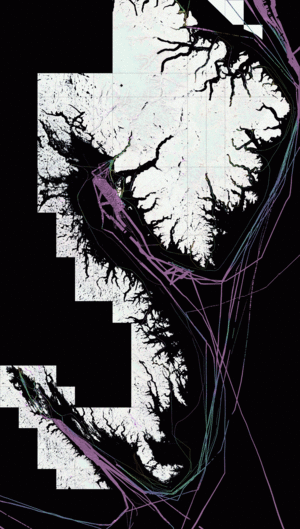



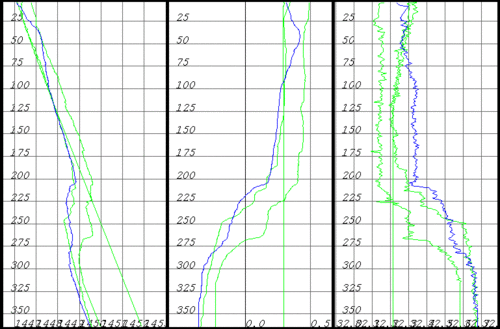
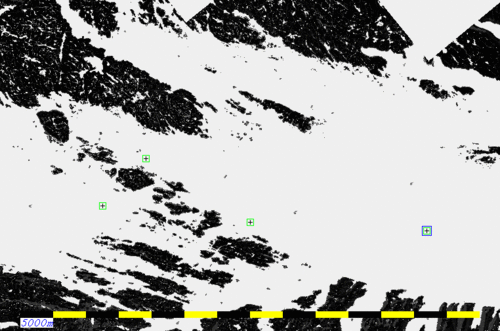
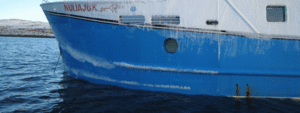
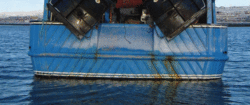


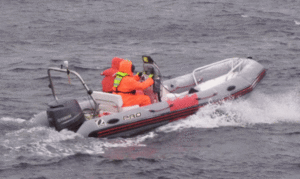
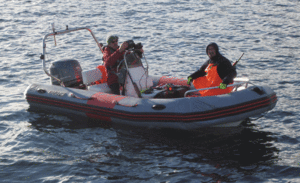
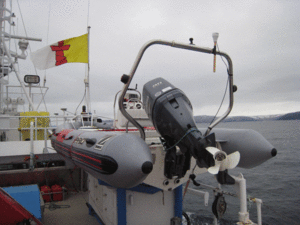
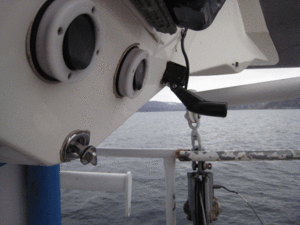
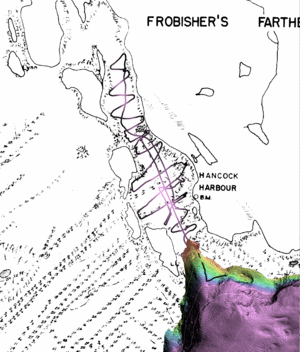
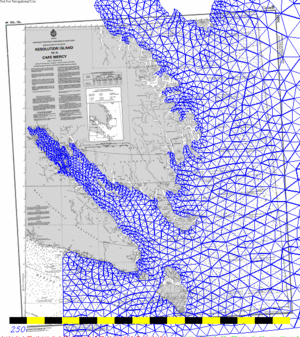
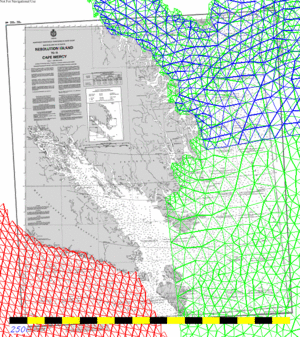
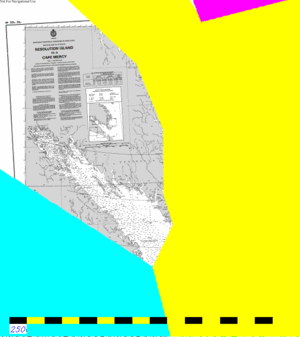
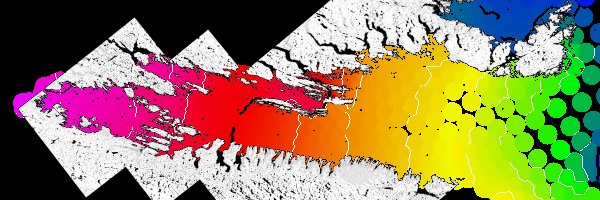
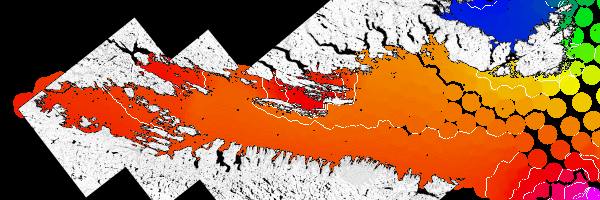
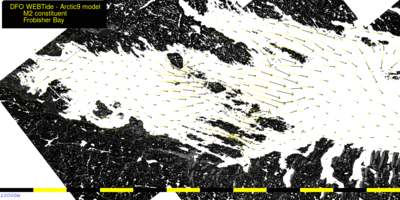 .
.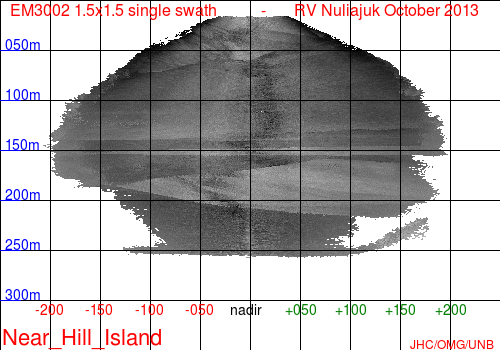
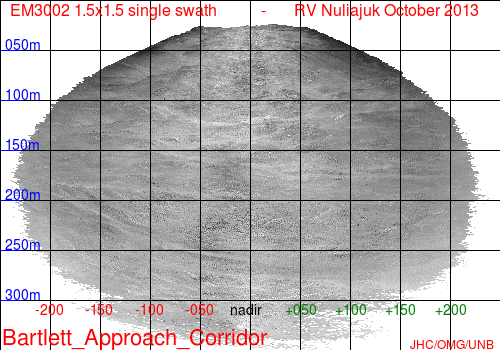
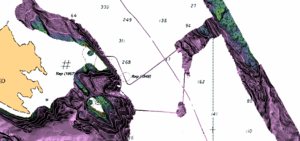 Ideally,
for depths greater than ~ 150m, a lower frequency multibeam should
be used. As the areas covered routinely dropped in and out of the
maximum achievable depth, lots of data cleaning has been required to
edit out the mistracking in the event of an "unfathomable" bottom.
The system has to be kept logging even after the bottom tracking has
been lost in case the seabed rises up again. For those instances,
the Furuno single beam data is substituted.
Ideally,
for depths greater than ~ 150m, a lower frequency multibeam should
be used. As the areas covered routinely dropped in and out of the
maximum achievable depth, lots of data cleaning has been required to
edit out the mistracking in the event of an "unfathomable" bottom.
The system has to be kept logging even after the bottom tracking has
been lost in case the seabed rises up again. For those instances,
the Furuno single beam data is substituted.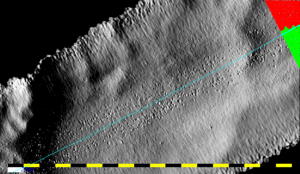 EM3002 - near
nadir tracking noise:
EM3002 - near
nadir tracking noise:







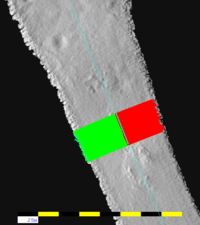 EM3002 - outer
beam low S/N:
EM3002 - outer
beam low S/N: 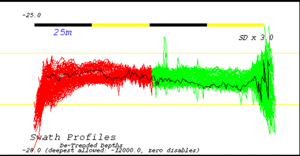



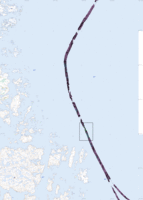 Open Water Shoal
Constriction:
Open Water Shoal
Constriction:
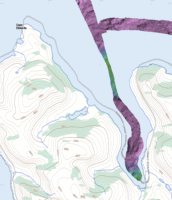 Cape Edwards Anchorage:
Cape Edwards Anchorage: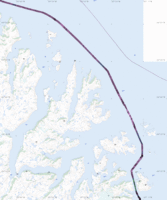 Littlecote Channel
to Neptune Bay:
Littlecote Channel
to Neptune Bay: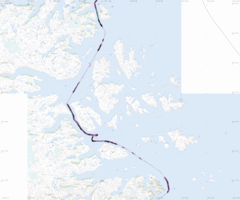 Popham
Bay:
Popham
Bay: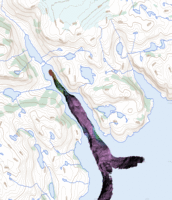 Cape St. David Anchorage:
Cape St. David Anchorage: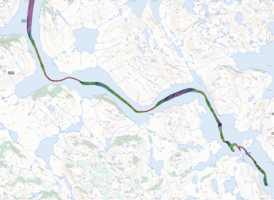 Anderson Channel:
Anderson Channel: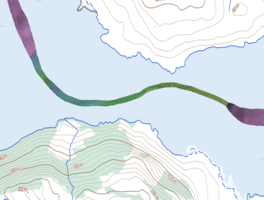
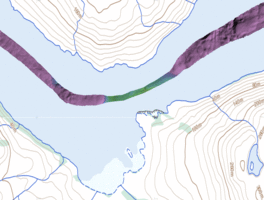
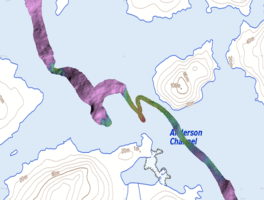
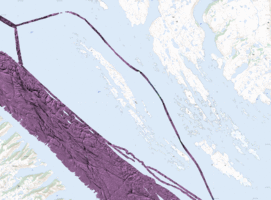 Between Maclean
and Gabriel Islands:
Between Maclean
and Gabriel Islands:
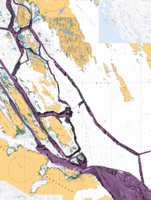 Approaches to
Bartlett Narrows and Deep Passage:
Approaches to
Bartlett Narrows and Deep Passage: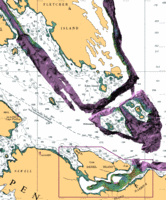 Fletcher Channel
Approaches:
Fletcher Channel
Approaches: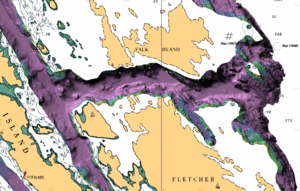 Falk Channel:
Falk Channel: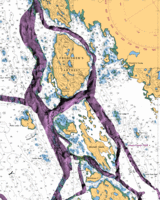 Algerine and Deep Passages:
Algerine and Deep Passages: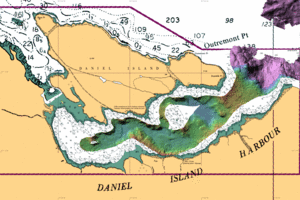 Daniel Island Harbour:
Daniel Island Harbour: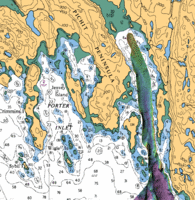 Lewis Bay:
Lewis Bay: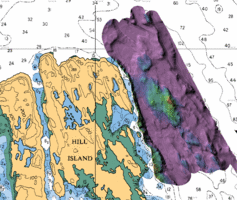 Western Iqaluit Anchorage:
Western Iqaluit Anchorage: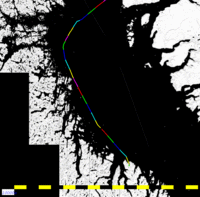 October 21st
(JD294): - Departed Pangnirtung at 0600. F185 heading clearly
wrong. Rebooted and calibrated while steaming out of Pang Fjord.
Reacquired calibration and logged data on north flank of coverage.
Over Pang Sill with ~ 15m water (schools of fish on sill top
providing false targets for searchlight sonar).
October 21st
(JD294): - Departed Pangnirtung at 0600. F185 heading clearly
wrong. Rebooted and calibrated while steaming out of Pang Fjord.
Reacquired calibration and logged data on north flank of coverage.
Over Pang Sill with ~ 15m water (schools of fish on sill top
providing false targets for searchlight sonar).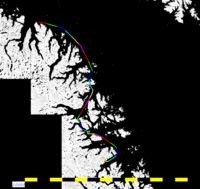 October 22nd
(JD295): - Departed Cape Edwards anchorage at 0600 but F185
heading clearly wrong - waited 45 minutes while rebooted and tried
to reacquire a calibration. Finally achieved this outside harbour.
Uneventful transit until turned inshore to attempt Popham Bay transit.
October 22nd
(JD295): - Departed Cape Edwards anchorage at 0600 but F185
heading clearly wrong - waited 45 minutes while rebooted and tried
to reacquire a calibration. Finally achieved this outside harbour.
Uneventful transit until turned inshore to attempt Popham Bay transit. 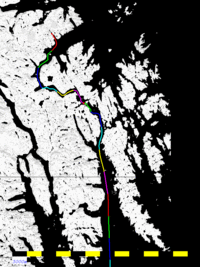 October 23rd
(JD296): - Departed Cape St. David anchorage at 0600. F185
working well. 3.5 kHz turned on after consultation with Knudsen
technical support.
October 23rd
(JD296): - Departed Cape St. David anchorage at 0600. F185
working well. 3.5 kHz turned on after consultation with Knudsen
technical support. 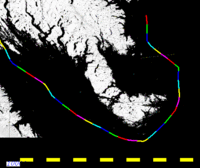
 October 24th (JD297):
- at dawn, transited through the line of soundings between Maclean and Gabriel
Islands. 1-1.5 knot flood tide current with us. Then developed
the first line of a corridor just
to the south of reported rock and shoal areas toward Bartlett
Narrows and Algerine Passage.
October 24th (JD297):
- at dawn, transited through the line of soundings between Maclean and Gabriel
Islands. 1-1.5 knot flood tide current with us. Then developed
the first line of a corridor just
to the south of reported rock and shoal areas toward Bartlett
Narrows and Algerine Passage.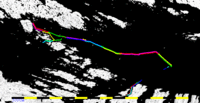 October 25th
(JD298): - Departed Daniel Island Harbour anchorage at
0700. ran east across preexisting deep Amundsen coverage to a
point where EM3002 tracking depths are viable. Built a corridor
north to join the incoming transit on the 24th. Ran that up to
the mouth of the Bartlett Narrows. Once at the mouth as it was close
to HW, so we ran two lines through Bartlett
Narrows, in and back out again.
October 25th
(JD298): - Departed Daniel Island Harbour anchorage at
0700. ran east across preexisting deep Amundsen coverage to a
point where EM3002 tracking depths are viable. Built a corridor
north to join the incoming transit on the 24th. Ran that up to
the mouth of the Bartlett Narrows. Once at the mouth as it was close
to HW, so we ran two lines through Bartlett
Narrows, in and back out again.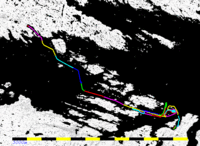 October 26th
(JD299): - Departed Daniel Island Harbour anchorage at
0700. Ran a constraining survey around the "Bird"
Islands (Gander, Nesters, Gosling, Kittiwake). Then proceeeded to
define the deep water
approaches to the constriction at the mouth of the Fletcher
Channel.
October 26th
(JD299): - Departed Daniel Island Harbour anchorage at
0700. Ran a constraining survey around the "Bird"
Islands (Gander, Nesters, Gosling, Kittiwake). Then proceeeded to
define the deep water
approaches to the constriction at the mouth of the Fletcher
Channel. 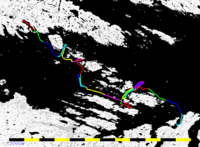 October 27th
(JD300): - left Lewis Bay at 0700. Added two lines on either
side of the
Algerine and Deep Passage
transit corridor. And added two lines on either side of the Bartlett Narrows Corridor. Then
proceeded to expand the Fletcher Channel as HW approached. On
returning NW along Fletcher we decided to turn into the opening to
the east that lead to the gap between Fletcher and Falk Islands.
Prior soundings only extended ~ 1/2 a mile in but indicated over
200m of water.
October 27th
(JD300): - left Lewis Bay at 0700. Added two lines on either
side of the
Algerine and Deep Passage
transit corridor. And added two lines on either side of the Bartlett Narrows Corridor. Then
proceeded to expand the Fletcher Channel as HW approached. On
returning NW along Fletcher we decided to turn into the opening to
the east that lead to the gap between Fletcher and Falk Islands.
Prior soundings only extended ~ 1/2 a mile in but indicated over
200m of water. 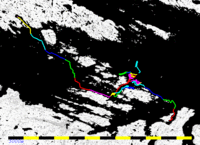 October 28th
(JD301): - Departed Daniel Island Harbour anchorage at
0700. ran up the eastern flank of the island chain, landward
of our previous tracks. Defining the 40m contour most of the
way. Started better defining the mouth of the Falk Channel. Also established that the
two rocks awash are not part of the same reef. It is possible to
steam between the two and around to the west of the southern shoal.
The reported obstruction does not appear to exist. Investigated
shoaler soundings in the deep water between the channel mouth and
our transit corridor to the NE.
October 28th
(JD301): - Departed Daniel Island Harbour anchorage at
0700. ran up the eastern flank of the island chain, landward
of our previous tracks. Defining the 40m contour most of the
way. Started better defining the mouth of the Falk Channel. Also established that the
two rocks awash are not part of the same reef. It is possible to
steam between the two and around to the west of the southern shoal.
The reported obstruction does not appear to exist. Investigated
shoaler soundings in the deep water between the channel mouth and
our transit corridor to the NE. 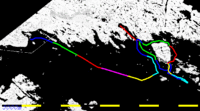 October 29th
(JD302): - up anchor at 0700. Prepared RIB for tide gauge
deployment. ~25 knot winds from the NW, with significant seas.
Dropped off at ~ 0845 in lee of island closing off Hancock Harbour.
Weston and Levi attempted to communicate with the submerged tide
gauge. No luck. Deck unit clearly transmitting and codes used were
based on the deployment log. RIB proceeded to undertake single beam
reconnaissance mapping of Hancock inlet to better define entry
depths. Nuliajuk surveying to the south, but sea states marginal for
quality data collection. Picked up RIB at about 1030. Decided to
take the shelter of Frobisher's Farthest and run the Mandarin Passage. Then proceeded to
survey just south of Lewis Bay in partial lee of coastline.
October 29th
(JD302): - up anchor at 0700. Prepared RIB for tide gauge
deployment. ~25 knot winds from the NW, with significant seas.
Dropped off at ~ 0845 in lee of island closing off Hancock Harbour.
Weston and Levi attempted to communicate with the submerged tide
gauge. No luck. Deck unit clearly transmitting and codes used were
based on the deployment log. RIB proceeded to undertake single beam
reconnaissance mapping of Hancock inlet to better define entry
depths. Nuliajuk surveying to the south, but sea states marginal for
quality data collection. Picked up RIB at about 1030. Decided to
take the shelter of Frobisher's Farthest and run the Mandarin Passage. Then proceeded to
survey just south of Lewis Bay in partial lee of coastline. 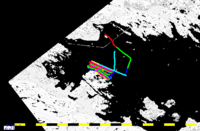 October 30th
(JD303): - Picked up GN representatives at 0700. Proceeded to
Hill Island Area. Did a
CTD in 250m of water and surveyed until ~ 1500. After that we
conducted squat trials while transiting back to Iqaluit harbour.
October 30th
(JD303): - Picked up GN representatives at 0700. Proceeded to
Hill Island Area. Did a
CTD in 250m of water and surveyed until ~ 1500. After that we
conducted squat trials while transiting back to Iqaluit harbour.